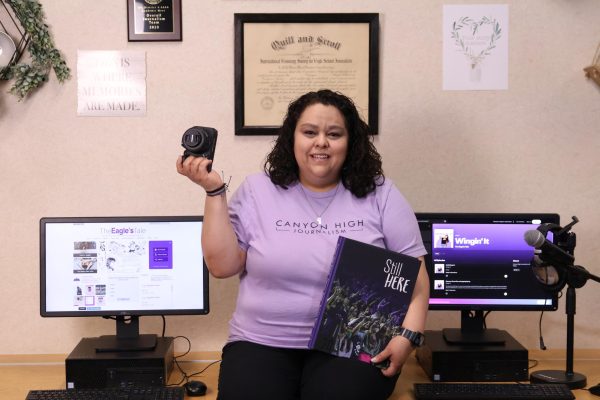Students compete in Randall County Junior Livestock Show
Junior Katelyn Brownd shows a steer at the Randall County Junior Livestock Show.
Throughout the week of Jan. 15, multiple students participated in the Randall County Junior Livestock Show and sale, where they showed livestock and competed in events leading to the premium sale Monday, Jan. 21.
The 71st annual event included 233 students from around the county and more than 550 animal entries. Freshman Ben Tyson has showed pigs for about six years.
“It went on all week,” Tyson said. “It started on Tuesday where we had the cattle show. Wednesday we had the poultry and rabbit show, Thursday we had the sheep and goat show, Friday all the pigs went in, and then Saturday we had the gilt and the boar show.”
Tyson said the pigs come around September or October.
“You have to feed them and train them,” Tyson said. “By that I mean you teach them four simple commands. Go forward. Turn left. Turn right and get your head up. There are a lot of other sub-commands you could add to that. A lot of breeds are known for being hard-headed. With that they like to run to the gate, so you have to teach them not to do that. You have to control them to stay away.”
Tyson said the judges also look at the skin and hair of the pig.
“It’s preferable to wash them once every two weeks,” Tyson said. “You also have to condition them. Once thing you can do is mix cocoa butter with water then you put it in a pump up sprayer and spray them. It’s like lotion for them.”
Junior Lucas Bradshaw and his family show a multitude of livestock. Bradshaw showed three sheep throughout the course of the livestock show.
“We’ve done sheep since I was in fifth grade,” Bradshaw said. “It’s definitely changed over the years. I was sort of the guinea pig in the process because I’m the oldest, but as we’ve gone forward and went in-depth in this process we’ve gotten better and better.”
Bradshaw has had the animals since June when the preparation started.
“We’re up in the morning, feed them, and make sure they’re doing OK,” Bradshaw said. “We try to use animal husbandry to the max. We try to doctor them, exercise them, feed them and around the time before the show we’ll sheer them, work with them a little bit more. Right before we go in we usually wash them, clip them a little bit more, and make sure they’re looking and feeling the best they can.”
Raising sheep takes an average of 600 combined hours to raise. Steers take 700 hours, followed by pigs at 300 hours, rabbits at 250 hours, and broilers (poultry) at 280 hours .
“About three to four times a week we’ll exercise them,” Bradshaw said. “We’ll put them on treadmills; we’ll run them outside. Usually a daily thing we’ll do is feed them and change their waters and make sure they’re doing OK. Feeding them is a grueling process but it’s probably the number one thing to focus on.”
Bradshaw will seek a career in agriculture.
“It teaches me a lot about animals, animal husbandry, how to care for them but it also teaches me responsibility,” Bradshaw said. “I have to push myself to work with these animals and strive for peak performance of these animals and myself so I can do the best I can and take care of this animal the best I can.”
Bradshaw said in the process patience and perseverance pays off.
“You have these animals for the majority of the year,” Bradshaw said. “It’s usually a grueling process to take care of them and to do all the work with them. But after you take them to a show and you go through all the experience and they’re all gone, you look back in retrospect and think ‘man that was really cool, that was really fun,’ and I feel like you get a little bit more of that every year.”

Hello everybody! I'm a senior, and this will be my third and final year on staff. I will be one of the three editors-in-chief this year on The Eagle's Tale. Most of my work this year will be in news and sports. When I'm not at school or work, I love spending...











